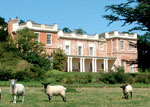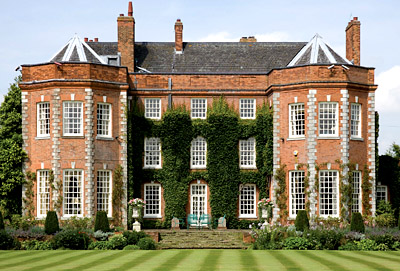Luxury property for sale in Leciestershire
Country Life launched two important listed properties onto the market in Leicestershire


The recent cold snap may have curtailed the activities of Leicestershire's fox-hunting community, but it's business as usual for house hunters, with the intrepid Rupert Sweeting of Knight Frank leading the way. He's handling the launch in this week's Country Life of illustrious 18th-century Peatling Hall, in the heart of Fernie Hunt country near the village of Peatling Parva, 11 miles west of Market Harborough. Knight Frank (020-7629 8171) quote a guide price of £4.75 million for the Grade II*-listed house and its ancillary buildings set in 60 acres of delightful gardens, grounds and parkland, or ‘just under £4m' for the main house minus the two gate lodges and a few small parcels of land.
Built of brick with stone quoins under a Swithland-slate roof, Peatling Hall started life in the early 1700s as a modest Queen Anne farmhouse, which was later enlarged and altered a number of times, notably in 1910 when the Arts-and-Crafts architect Detmar Blow added two new bays to complete the symmetry of the house, with the north and south sections having two floors, and the centre section three floors. Blow also moved the front door round to the south and added the projecting full-height porch. The tall 30-light sash windows, which allow light to flood the main rooms, have also been attributed to him.
Over the years, the hall has been home to some of Leicestershire's most distinguished families, among them the Clarkes-John Clarke was High Sheriff of the county in 1820-the Gemmills, the Lilleys, and, for the past 37 years, to former High Sheriff Ian McAlpine and his family. Before the First World War, Peatling Hall was the focal point of an 1,100-acre estate, but that had been reduced to 45 acres by the time Mr McAlpine bought the house. Over the years, he's enhanced the property by buying additional land and cottages-especially the pretty gate cottage, the purchase of which took more than 30 years to negotiate.

Peatling Hall (pictured) itself ‘wasn't in a bad state' when the McAlpine family moved in, and, by and large, was structurally sound, apart from the fact that there was no central heating upstairs, and the plumbing and wiring were definitely suspect. In a first wave of refurbishment-and again more recently the whole of the interior was redecorated and the original 12 bedrooms reduced to the present seven bedroom suites.
The hall's 11,877sq ft of accommodation includes three elegantly furnished main reception rooms, a sitting room, a splendid kitchen/breakfast room, a dining room and a huge white-painted garden room with 11 pairs of French windows opening onto the walled garden and the heated swimming pool, plus attics and cellars. Outbuildings include a coach house with two cottages, stabling and stores. ‘As the first major country-house sale of the year in this prosperous part of the country, Peatling Hall is sure to create quite a stir in the marketplace,' comments Mr Sweeting.
Next week's Country Life will see the launch onto the market of another fine listed building-Grade II-listed Rempstone Hall, near Loughborough, on the Leicestershire/Nottinghamshire border. Strutt & Parker (01858 433123) quote a guide price of £2.5m for the hall, set in 22 acres of gardens, woodland and pasture, which has been home since 1978 to an order of Anglican nuns, who plan to use the proceeds to finance the construction of a brand-new, modern convent.
Rempstone Hall was built in the late 18th century for William Gregory Williams, whose forebears were major landowners in the area, and substantially altered in the late 19th and early 20th centuries. When William died in 1814, his estates passed to his only son Gregory, who also inherited the Harlaxton and Nottingham estates from his uncle, George de Ligne Gregory, in 1822, and later built Harlaxton Manor, near Grantham.
Exquisite houses, the beauty of Nature, and how to get the most from your life, straight to your inbox.
It is unclear whether Gregory sold or let the hall to its next distinguished occupier, John Smith Wright of the Nottingham banking family, and his second wife, Lady Sarah Caroline Sitwell. Wright died in 1848, but Lady Sarah lived on until 1860, dying at the age of 80. Her first husband was Sir Sitwell Sitwell of Renishaw Hall, Derbyshire, who died in 1811, and even after her marriage to the wealthy Wright, she insisted on taking her widow's portion of £3,000 a year from the impoverished Sitwell estates for nearly 50 years. Lady Sarah was something of a blue stocking, and she entertained a wide circle of literary friends (probably including Lord Byron, whom she certainly knew) at the hall.
The hall stood empty at the turn of the 20th century until 1909, when P. W. Carr, a stockbroker, moved in. He made a number of alterations to the house, adding the north wing and the fine Edwardian stable block. In February 1920, Rempstone Hall was sold to the Derbyshire family, who in turn sold the house and its immediate surroundings to the Convent of the Holy Cross in 1978. At the time of the 1920 sale, the hall came with 152 acres, The Ship pub, several cottages, stabling for 20 horses, two entrance lodges, a stud-groom's house and ‘a stately and heavily timbered park of great beauty'.
Today, the property, which has been carefully maintained throughout, comprises the hall with four reception rooms, a drawing room/chapel, a library, 10 main bedrooms, 10 secondary bedrooms, and six bathrooms, plus two lodges, a flat, an impressive stable courtyard, and a walled kitchen garden. It is being offered as a whole or in three lots, and could easily revert to its former residential use, says selling agent Richard Brooks of Strutt & Parker.
* For more properties like this every week, subscribe and save
Country Life is unlike any other magazine: the only glossy weekly on the newsstand and the only magazine that has been guest-edited by His Majesty The King not once, but twice. It is a celebration of modern rural life and all its diverse joys and pleasures — that was first published in Queen Victoria's Diamond Jubilee year. Our eclectic mixture of witty and informative content — from the most up-to-date property news and commentary and a coveted glimpse inside some of the UK's best houses and gardens, to gardening, the arts and interior design, written by experts in their field — still cannot be found in print or online, anywhere else.

